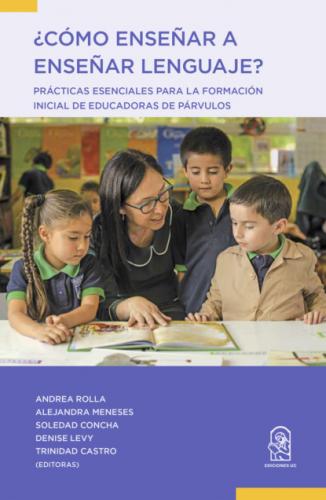Ball, D. L. & Forzani, F. M. (2010). What does it take to make a teacher? Phi Delta Kappan, 92(2), 8-12. doi: 10.1177/003172171009200203
Beck, I. L. & McKeown, M. G. (2007). Increasing young low-income children’s oral vocabulary repertoires through rich and focused instruction. The Elementary School Journal, 107, 251-271.
Beck, I., McKeown, M. & Kucan, L. (2008). Bringing words to life. Robust vocabulary instruction. New York, NY: The Guilford Press.
Bonwell, C.C. & J. A. Eison. (1991). Active learning: Creating excitement in the classroom. ASHEERIC Higher Education Report No. 1. George Washington University, Washington, DC.
Çakırog˘ lu, Ü., Basıbüyük, B., Güler, M., Atabay, M., & Yılmaz Memis, B. (2017). Gamifying an ICT course: Influences on engagement and academic performance. Computers in Human Behavior, 69, 98-107.
Cartun, A., Schutz, K., Kellwy-Petersen, M. & Franke, M. (2018). Core practices and teacher education curriculum. Stories of practice. En P. Grossman, (Eds). Teaching core practices in teacher education (pp. 107-133). Cambridge, MA: Harvard Education Press.
Cochran-Smith, M. & Lytle, S. (1999). Relationships of knowledge and practice: Teacher learning in communities. Review of Research in Education, 24, 249-305.
Darling-Hammond, L., Hammerness, K., Grossman, P., Rust, F. & Shulman, L. (2005). The design of teacher preparation programs. En L. Darling-Hammond & J. Bransford. (Eds.). Preparing teacher for changing world: What teachers should learn and be able to do (pp. 390-441). San Francisco, CA: Jossey-Bass.
Darling-Hammond, L. & Bransford, J. (2005). Preparing teachers for a changing world: What teachers should learn and be able to do. San Francisco: Jossey-Bass.
Fiorella, L. & Mayer, R. E. (2016). Eight ways to promote generative learning. Educational Psychology Review, 28(4), 717-741. doi: 10.1007/s10648-015-9348-9
Freeman, S., Eddy, S. L., McDonough, M., Smith, M. K., Okoroafor, N., Jordt, H. & Wenderoth, M. P. (2014). Active learning increases student performance in science, engineering, and mathematics. PNAS Proceedings of the National Academy of Sciences of the United States of America, 111(23), 8410-8415. doi: 10.1073/pnas.1319030111
Goeze, A., Zottmann, J. M., Vogel, F., Fischer, F. & Schrader, J. (2014). Getting immersed in teacher and student perspectives? Facilitating analytical competence using video cases in teacher education. Instructional Science, 42(1), 91-114. doi: 10.1007/s11251-013-9304-3
Grossman, P., Compton, C., Igra, D., Ronfeldt, M., Shahan, E. & Williamson, P. (2009). Teaching practice: A cross-professional perspective. Teachers College Record, 111(9), 2055-2100.
Grossman, P., Hammerness, K. & McDonald, M. (2009). Redefining teaching, re-imagining teacher education. Teachers and Teaching: Theory and practice, 15, 273-289.
Grossman, P., Kavanagh, S. S. & Pupik, C. (2018). The turn towards practice-based teacher education: Introduction to the work of the Core Practice Consortium. En P. Grossman, (Eds). Teaching core practices in teacher education (pp. 1-14). Cambridge, MA: Harvard Education Press.
Grossman, P. & McDonald, M. (2008). Back to the future: Directions for research in teaching and teacher education. American Educational Research Journal, 45(1), 184-205. doi:10.3102/0002831207312906
Lampert, M., Franke, M. L., Kazemi, E., Ghousseini, H., Turrou, A. C., Beasley, H., Cunard, A. & Crowe, K. (2013). Keeping it complex: Using rehearsals to support novice teacher learning of ambitious teaching. Journal of Teacher Education, 64(3), 226-243.
Lonigan, C. J., Shanahan, T. & Cunningham, A. with the National Early Literacy Panel. (2008). Impact of shared-reading interventions on young children’s early literacy skills. In Developing early literacy: Report of the National Early Literacy Panel (pp. 153-166). Louisville, KY: National Center for Family Literacy.
McDonald, M., Kazemi, E. & Kavanagh, S. S. (2013). Core practices and pedagogies of teacher education: A call for a common language and collective activity. Journal of Teacher Education 64(5), 378-386.
Michigan Association of Intermediate School Administrators General Education Leadership Network Early Literacy Task Force (2016). Essential instructional practices in early literacy: Prekindergarten. Lansing, MI: Authors.
Müller, M. & García, A. (2016). Manual sistema de prácticas Educación UC. Recuperado de http://practicaspedagogicas.uc.cl/images/manuales/Manual%20Sistema%20de%20Prcticas%20UC.pdf
Prince, M. (2004). Does active learning work? A review of the research. Journal of Engineering Education, 93(3), 223-231.
Richmond, A. R. & Hagan, L. K. (2011). Promoting higher level thinking in psychology: Is active learning the answer? Teaching of Psychology 38(2), 102-105. doi:10.1177/0098628311401581
Strasser, K., Mendive, S. & Barra, G. (2020). Manuscrito en preparación.
Schneider, M. & Preckel, F. (2017). Variables associated with achievement in higher education: A systematic review of meta-analyses. Psychological Bulletin, 143, 565-600. doi: 10.1037/bul0000098
Schutz, K., Grossman, P. & Shaughnessy, M. (2018). Approximations of practice in teacher education. En P. Grossman, (Eds). Teaching core practices in teacher education (pp. 57-84). Cambridge, MA: Harvard Education Press.
Shulman, L. (1987). Knowledge for teaching. Foundations of the New Reform. Harvard Educational Review, 57(1), 1-21.
Sweller, J. (2010). Element interactivity and intrinsic, extraneous, and germane cognitive load. Educational Psychology Review, 22, 12٣-1٣٨.
Teacher Education by Design. (2014). University of Washington College of Education.
Teaching Works (2019). Teaching Works Resource Library. Recuperado de https://library.teachingworks.org/
Wittrock, M. C. (1974 / 2010). Learning as a generative process. Educational Psychologist, 45(1), 40-45. doi: 10.1080/00461520903433554 (Trabajo original publicado 1974).
Créditos Figura 1, p. 47
Ícono “Teaching” y “Eye” realizado por Freepik de www.flaticon.com
Ícono “Settings” realizado por SBTS2018 de www.flaticon.com
Ícono “Observation” realizado por Smashicons de www.flaticon.com
[1] Las prácticas clave y las pedagogías de la práctica han sido propuestas por Core Practicum Consortium (https://www.corepracticeconsortium.com/), entidad que reúne a académicos y profesores, principalmente, estadounidenses de distintos niveles escolares, áreas disciplinares
